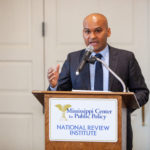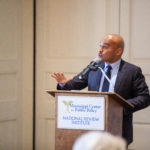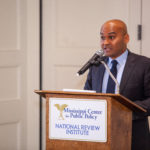If Mississippi would choose the economic liberty model of limited government and free markets, it would see income growth and poverty reduction.
In simple terms, we’ve advocated for a path to prosperity. That path is built from policies that favor capitalism, free enterprise, robust competition and consumer choice. We do not believe there is another path that leads to durable prosperity, including the path that requires government to involve itself heavily in the orchestration of the economy.
At the end of October, the Fraser Institute, a leading think tank and research institution, published the "Economic Freedom Report for North America." The report measures the degree to which the policies and institutions of states and countries are supportive of economic freedom. The cornerstones of economic freedom are personal choice, voluntary exchange, freedom to enter markets and compete, and security of the person and privately owned property. Forty-two data points are used to construct a summary index and to measure the degree of economic freedom. This report has been published every year since 1986 and is regarded globally as one of the most robust and reliable measurements of economic freedom. Mississippi again ranked in the bottom quartile this year. Among the other states joining Mississippi in that quartile were California, Oregon, Minnesota, New York and Vermont.
Mississippians have very little in common with any of these states. These states are not geographically, politically, historically, or culturally similar to the Magnolia State. In fact, about the only thing Mississippi has in common with these states is its lack of economic freedom.
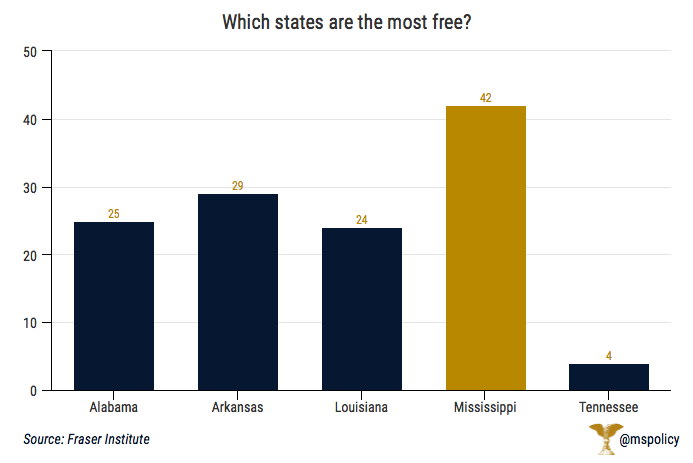
When we looked at the Fraser Index, which ranked Mississippi at #42 in 2018, we also noted that none of our neighbors were ranked as poorly. In fact, the average ranking for our contiguous neighbor states was #21 and no state ranked higher than #29. If you look to the 11 states making up the Southeast, from Virginia to Texas, the average ranking was 17.
Despite our advocacy for policies based on economic freedom, there remain leaders in Mississippi who seem unconvinced. There remain advocates for more and more reliance on the public sector. Many claim Mississippi is uniquely inoculated from experiencing economic growth and poverty reduction through the free market. Some even claim our lack of economic growth and poverty reduction is irrecoverably tied to our history or our geography. If only there was an example of a state that previously had similar economic freedom scores but embraced economic freedom polices over time and significantly improved the lives of its citizens as a result. If only we had data over the past twenty years than could show us how poverty can be reduced and per capita income can be increased in a state like Mississippi when freedom is the central public policy. Rather than one state, we’ve identified two states than serve as shining examples.
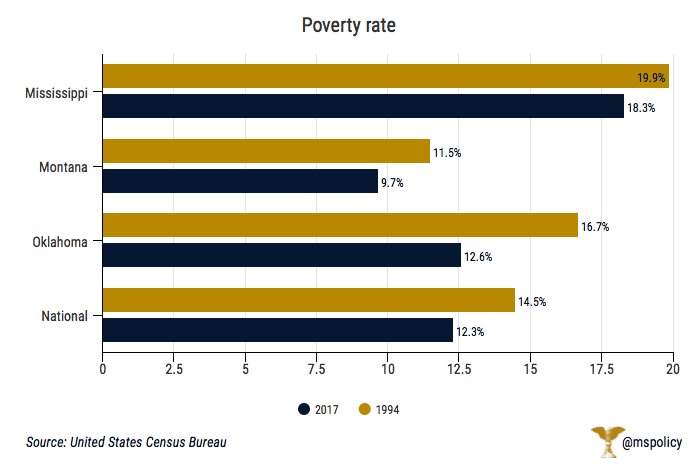
Let’s start by looking at the national poverty rate. In 1994, the rate was 14.5%. Today, the national average is 12.3%, a 15% reduction. In Mississippi in 1994, the poverty rate was 19.9%. Today, the rate is 18.3%, an 8% reduction. In Oklahoma in 1994, the poverty rate was 16.7%. Today, the rate is 12.6%, a 25% reduction. In Montana in 1994, the poverty rate was 11.5%. Today, the rate is 9.7%, a 16% reduction.
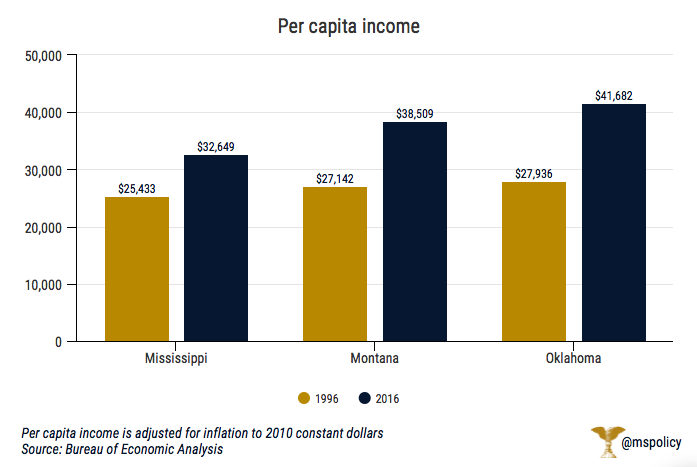
Next, let’s look at per capita income for the three states over a 20-year period. In 1996, the average income in all three states was very similar. In Mississippi, the average income was $25,433 (48thin the nation). Montana had an average income of $27,142 (46th) and Oklahoma $27,936 (45th). Twenty years later, Oklahoma had risen to 28thwith an average income of $41,682. Montana had risen to 38thwith an average income of $38,509. Over that same 20-year period, Mississippi slipped two sports to 50thplace with an average income of $32,649.
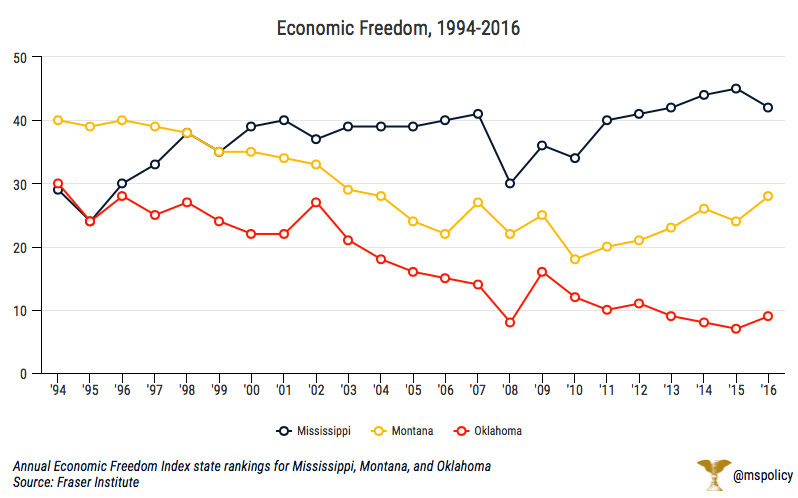
If we go back to the Fraser Institute Economic Freedom Index and plot how each of the three states performed in the same years (1994 to 2016), we see the strong correlation between economic freedom and prosperity. It is stark visual evidence of the power of choosing economic freedom. In 1994, Mississippi was ranked slightly more economically free than Oklahoma and considerably more so than Montana. Over the ensuing 22 years, Mississippi moved steadily away from economic freedom and the results are evident.

There is another valuable set of data that helps demonstrate the policy point as we compare Mississippi, Oklahoma and Montana. The Tax Policy Center, a joint project of the Urban Center and the Brookings Institute, publishes a report on state and local tax revenue as a percentage of personal income in each state. From 1997 to 2015, the tax burden in Oklahoma fell from 10.11 to 8.42. In Montana, the burden was reduced from 10.83 to 9.52. In Mississippi, the tax burden increased from 10.23 to 10.57. No other state in the Southeast had a burden at or above 10.0. At 10.57, Mississippi finds itself once again in the company of states like California, New York, New Jersey, Minnesota and Illinois.
What is the data and evidence telling us? It is informing us to choose capitalism and free markets. It’s telling us to move away from a “command and control” economic system and start relying more on individual freedom, consumer choice, and private competition. It’s telling us to allocate more resources towards free enterprise and fewer resources towards the political process. If we can start to get Mississippi’s economy growing by adopting policies that prioritize economic liberty, we can experience prosperity.
When states grow, other measures of quality of life are improved. Educational outcomes improve. Crime rates go down. Health measures improve and life expectancy expands. Montana and Oklahoma are real-life examples of how lives can be measurable improved when states make a commitment to economic freedom. They’ve shown us the road map. There is no reason Mississippi can’t take the road to freedom. All it takes is the will and strong leadership to take the first steps.
This column appeared in the Clarion Ledger on December 9, 2018.
Occupational licensing laws force Mississippians to spend time and money to receive permission from the government before they can earn a living.
This is a relatively new phenomenon. In the 1950s, just five percent of the workforce needed a license to legally work. At the time, occupational licensing was largely limited to medical professionals, lawyers, and teachers. However, as we often see when government is involved, license requirements have expanded dramatically.
Today, approximately 19 percent of Mississippians need a license to work. This includes everything from a shampooer, who must receive 1,500 clock hours of education, to a fire alarm installer, who must pay over $1,000 in fees. All totaled, there are 66 low-to-middle income occupations that are licensed in Mississippi.
As new licenses have been added to the books in Mississippi, it is safe to assume that each proponent, usually an occupational licensing board, made the same central argument. We must do this in the name of consumer safety to protect individual citizens. But the reality is often something less altruistic. Mainly, these occupational associations are more interested in building a moat around their industry with the help of government. The harder it is for someone to enter an industry, the less competition and consumer choice the industry incumbents face.
This may artificially raise the wages of industry practitioners by raising the prices of goods and services that require such licenses, but it does so by limiting options and increasing consumer costs. This will often have an outsized impact on low-income Mississippians, who then have to make otherwise unnecessary decisions on what they will or will not purchase.
Just this past year, the Mississippi legislature, with little discussion and few dissenting votes, passed a bill to make it more difficult to become a real estate broker. The proposed law sought to increase the time it would take to become a broker, going from the current one year to three years. Fortunately, Gov. Phil Bryant vetoed the legislation.
Who were the individuals supporting such legislation? Was it the Coalition of Mississippians Against Inexperienced Brokers? A group of citizens negatively impacted by brokers who had just one year of experience? No, it was, naturally, the Realtors Association.
But the bigger problem isn’t just one specific association pushing the legislature to limit competition, it is the cost of all unnecessary and burdensome regulations on Mississippi’s economy.
According to a new report from the Institute for Justice, Mississippi has lost 13,000 jobs because of occupational licensing and the state has suffered an economic value loss of $37 million. To put that into perspective, just by legislative action to rollback unnecessary licenses, we can create two Nissan plants…without spending a dime of taxpayer dollars.
Instead of relying on government, these are the actions that will encourage and promote economic growth in Mississippi. If that is our goal, we need to trust in the benefits of the free market and a “lighter touch” from government and occupational licensing regimes and we need to return to a belief in individual responsibility.
This can be achieved in a number of ways. For example, voluntary certification offers an avenue for reform. This already occurs in many industries and allows private third-parties to set standards for individuals to voluntary subscribe as one level of quality assurance.
One of the more widely recognized private certifications is the Automotive Service Excellence (ASE) certification for mechanics. You can open a garage tomorrow with – or without – the ASE certification and customers may or may not care.
But that decision is left to the entrepreneur and the customer, not to the government or the industry lobbyist or the board of licensure. We can do this with any number of professions currently licensed by the state. If we really want more jobs and fewer people dependent on government, it starts by creating an environment that encourages work; not one that encourages the creation of hurdles and obstacles.
This column appeared in the Madison County Journal on December 6, 2018.
The last time university officials in the Southeastern Conference capitulated to the demands of a student-led mob, things did not work out well for that school. It should serve as a lesson to all.
In Columbia, Missouri, in 2015, students put on the protest of the century – or at least that is how it seemed.
The funny thing about this protest is that it didn’t have any great meaning or purpose. This wasn’t the Vietnam War or ERA. It began with a complaint about cuts to health benefits for graduate-student employees. The student body president at the time, who is black and gay, stated that someone off-campus shouted racial slurs at him. There was a report of another racial slur at an anti-racism rally. And then there was the famous “poop swastika,” where someone supposedly drew a swastika on a bathroom wall in feces.
There was a sit-in, which led to the first round of capitulation. The university agreed to robust diversity training. When that didn’t go far enough, the president of the university system, Tom Wolfe, apologized and health benefits for the graduate student employees were restored. Still not enough to satisfy the hunger of the social justice crowd on campus. Wolfe had to go.
Then there was a hunger strike, led by a student named Jonathan Butler. None of this served to get any real traction or generate national attention. But then the authoritarian mob found a powerful ally: Members of the entire football team announced they were boycotting the next football game if Wolfe didn’t resign.
Under the pressure of national embarrassment and with the leverage of high-profile athletes, Wolfe resigned. Chancellor Bowen Loftin resigned as well. In order to relieve the pressure, the university completely capitulated in a desperate attempt to satiate the demands of the mob. After making the ultimate sacrifice of the system president and its chancellor, everything at Missouri returned to normal, right? Not exactly.
The protesters' tent city remained. And a new era of “wokeness” was ushered in and ESPN became a network for social justice warriors. A professor, Melissa Click, became famous for pushing away journalists trying to cover the story, at one point, yelling, “I’m going to need some muscle in here.”
Columbia, Missouri isn’t exactly Berkeley, Palo Alto, or Madison. After all of the accommodation and sacrificing of public figures to make peace with the social justice mob, a funny thing happened. People began to vote with their feet. Enrollment plummeted. The year the protests began, Missouri had a freshman class of 6,200. The following year, it was down to less than 4,800. And the year after, just 4,100 enrolled in the freshman class. And alumni not only stopped enrolling their children, they also quit giving.
As budgets depleted, more than 400 jobs were cut and several dorms were closed. At one point, dorms were even converted to motel rooms for visitors in town for sporting events.
The protesters may have claimed victory at the University of Missouri, but the school lost. Perhaps this was a warning sign.
It will be interesting to see how universities respond in the future, particularly those in the South. At the University of Mississippi, the largest university in the state where I live and work and my alma mater, protesters known as the Students Against Social Injustice recently staged a protest. They followed the now-common practice of issuing demands of the university.
According to SASI, the university must remove a Confederate statue from campus and speech codes must be implemented to “protect students from the racist violence we experience on campus.” This is similar to what students have been doing at the University of North Carolina at Chapel Hill for the past year, though to the credit of the protesters at Ole Miss, they didn’t actually attempt to tear down the statue. At least not yet.
The real issue isn’t the protests or the protesters themselves. Actual intellectual debate should be encouraged on college campuses. Diverse opinions should be tolerated, whether those opinions are popular or not. The issue is how university leadership responds. Schools must not be run by authoritarian mobs. If university administrations continue to buckle under the weight of social justice mobs, they may suffer the same consequences as the University of Missouri.
This column appeared in the Washington Examiner on November 5, 2018.
We can learn many wonderful lessons from Rudolph the Red-Nosed Reindeer. But more than that, it is something families with young children have enjoyed for generations.
On the Day after Thanksgiving, my wife, my three boys, and I sat down to watch the classic holiday movie, Rudolph the Red-Nosed Reindeer. Since that time, the boys have asked me to read the original book each night before bedtime. And I’m pretty sure they’ve asked their mamma to read it a time or two during the day.
Unbeknownst to me, I was apparently subjecting my children to levels of sexism, racism, homophobia, and bullying that may never be repaired. And you can go ahead and add any other phobias or “isms” that diligent, gender studies majors busy themselves discovering and warning the rest of us about.
Yes, Rudolph is the latest subject of our outrage culture. It seems there are more and more people who live their lives to be outraged. But this outrage seems quite the stretch.
As you probably know by now, this is not a joke, but an actual argument from Huffington Post. While most of America is laughing at the outrage, there are some who literally wake up each morning, scour the latest news, and then find something about which to be offended by. And then they write about it. And outlets like Huffington Post publish it
What is the goal? To bring down what you and I love? To shame the traditions people grew up with or the pastimes that make us feel good? If someone wants to be outraged by something, anything, they can be. They simply pick something, add an “ism” to it, and the story is written. However, in this case the story is really an attack on something families have enjoyed together for generations – a classic holiday tale. Personally, I don’t think it’s by accident.
These attacks are not isolated to Rudolph, and this won’t be the last time. When this passes, there will be something else in our culture to petition.
In this case, as is becoming the norm with the social outrage crowd, the attack doesn’t even make sense. Spoiler alert, the previously outcast misfit toys end the reign of terror brought on by the Abominable Snow Monster. Rudolph, the formerly shunned kid with unique qualities, saves Christmas and becomes the hero. The minority characters who were previously neglected and unfairly treated, are welcomed into the community and the lonely misfit toys are given loving homes.
Social justice is delivered by the acts of individuals seeking their place in the world and discovering the usefulness of their own individual blessings and others coming to recognize those gifts. No, there were no transgendered reindeer. Mrs. Donner doesn’t attend feminists book studies with Mrs. Claus. And the elves didn’t create a union and force members to pay mandatory dues. But the classic movie does teach a wonderfully “woke” story about the value of life and how we all have purpose in this world, even if it takes us, or our neighbors, a while to understand it.
Some people will never be happy. But whether it is something serious or a movie about a reindeer with a red nose, we should never give in to this authoritarian mob seeking to find offense with every tradition some may hold dear. With this mob, no concession will ever be enough.
I’m reminded of another classic children’s story in which the author warns, “if you give a mouse a cookie, he’ll just ask for a glass of milk.”
Americans have always been a transient people, often searching for new careers and better opportunities for their family.
Depending on the economy of the day, we see 30 to 40 million Americans move each year. And when they move, they bring their incomes with them. Between 1995 and 2010, some $2 trillion in adjusted gross income went from one state to another.
As a result, some states brought in billions more in incomes over the past 25 years while others lost that amount and then some.
Mississippi lost $132 million in annual AGI. Looking more closely at the state, Desoto county was the big winner, gaining $1.34 billion in annual AGI, mostly all of it from across the border in Shelby county, Tennessee. Rankin ($523 million) and Madison ($912 million) counties were the other big beneficiaries of wealth transfers in the state, but that was mostly from Hinds county, which lost $1.55 billion in annual AGI.
Not surprisingly, the Delta, which is shedding population, also saw big loses in income. The five counties of Bolivar, Coahoma, Leflore, Sunflower, Washington lost between $100 million and $250 million. That wealth was generally lost to either the Jackson metro area or both sides of the Mississippi/ Tennessee state line. Throughout the state, we saw a few areas of growth (such as Lafayette county) or decline (such as Lauderdale and Lowndes counties), but most other places were more or less stagnant. Very little wealth gained, very little wealth lost. And it was usually just in-state transfers.
The only other counties to see wealth gained from out-of-state were Hancock and Pearl River counties, along the Louisiana border. They both gained between $180 and $200 million, mostly from Louisiana.
However, Louisiana stood out as having the biggest losses in the South. The state lost some $8 billion in annual AGI, with more than $500 million shifted toward Mississippi. Among other neighbors, Alabama saw a gain of $2.5 billion and Arkansas saw a gain of $2.6 billion. Tennessee gained over $14 billion - even with the big loses from Shelby county to Desoto county.
Overall, the states that did the best won’t surprise many people. Arizona gained $35 billion in annual AGI, Texas gained $47 billion, and Florida gained $156 billion. That was at the expense of many states, but three in particular lost between $50 and $100 billion each year. This includes Illinois, California, and New York, the biggest loser of all. The Empire State lost $100 billion in annual AGI.
But why? After all, it’s tough to compete with Chicago, New York, San Francisco, and Los Angeles.
Because the states that Americans are moving to, and where they bring their income along, are low and no tax states. Florida and Texas do not charge you for working, while Arizona has a relatively low individual income tax rate. Certainly better than California, though that isn’t saying much.
When New York Gov. Andrew Cuomo was being criticized from both the left and the right for offering between $1.5 and $2 billion in taxpayer incentives to Amazon, he defended the decision saying his state needs to offer incentives to compete with states that don’t have an income tax. If a governor has to say that, it should highlight the lack of competitiveness that state has, regardless of what else it has to offer.
When states have higher tax rates, that naturally allows the state to confiscate more money from taxpayers and gives them the ability to dole out money to their preferred companies. Rather than let the market work, you have selected interests who are insulated from higher taxes at the expense of everyone else.
We all seem to understand the not-so-secret, secret sauce. Low taxes and a light regulatory touch lead to job growth. Americans then move to where there is a combination of good jobs, high quality of life, and reasonable housing costs. And the state’s that are doing things right are the ones who benefit. In other words, prosperity is closely linked to freedom-based public policies. If we want to grow and provide more opportunities in Mississippi, then let’s take the path that makes it easy to start a job, open a business, earn a side income, invest capital, serve customers, compete with incumbent businesses, and keep more of what we earn.
Three Mississippi legislators were elected to judicial posts this year, necessitating special elections for the final year of the legislative term. But none of the seats will be competitive from a partisan standpoint.
Rep. Brad Touchstone, a freshman Republican lawmaker from Oak Grove, was elected County Journal Judge in Lamar county on November 6. Touchstone was instrumental in the passage of the Occupational Board Compliance Act of 2017, key occupational licensure reform the legislature adopted two years ago.
The district is overwhelmingly Republican and certain to stay in the Republican column.
Two Democrats also won judicial positions. Rep. Adrienne Wooten of Jackson was elected a Hinds County Circuit Court judge while Rep. Willie Perkins of Greenwood was elected a chancery judge for the judicial district that covers Bolivar, Coahoma, Leflore, Quitman, Tallahatchie and Tunica counties.
Both of these districts are certain to stay in Democratic hands.
Gov. Phil Bryant will set a special election after the members formally resign from the legislature. The special election winners, particularly if they win a runoff, will only be present for a short period of time for the session that concludes the first week of April.
They will then have to get back on the campaign trail and win again in the fall when every seat in the legislature is on the ballot.
Thank you to everyone who joined us for Liberty Luncheon: Melting Pot or Civil War with National Review editor and author Reihan Salam.
Colleges and universities are supposed to be places where curiosity is developed and intellectual debate in encouraged. But with each passing day, it appears that the debate part of the equation is limited in favor of indoctrination, or at a minimum, silence.
Most people, regardless of their political leanings, understand the ideological beliefs of college professors. One 2016 survey from Econ Journal Watch showed liberal professors outnumber conservatives by a ratio of 12 to 1. Business and economic schools tend to have a narrower margin, though they still lean left, while social sciences and humanities are even more liberal than the median. The same survey showed liberals in history departments outnumber conservatives 34 to 1. None of this is surprising.
The same schools that pride themselves on diversity of race, gender, ethnicity, sexual orientation, and every other box the Departments of Diversity and Inclusion can check appear to have little interest in diversity of thought. However, the issue isn’t that most professors are liberal; that alone is not the problem. The issue is that everyone must conform to those “preferred” beliefs. Or, at a minimum, pressure is put on students to keep their differing opinions to themselves. At least that is how college students feel.
In a recent survey of full-time undergraduate students by McLaughlin & Associates on behalf of Yale’s William F. Buckley, Jr. Program, a majority, 52 percent, said professors often use class time to express their social or political beliefs completely unrelated to the subject of the class. And 53 percent said they often “felt intimidated” in sharing ideas or opinions that were different from their professors.
The problem extends beyond professors. The students who hold those majority views on many campuses often don’t want debate either. Fifty-nine percent of students agreed that a college “should forbid people from speaking on campus who have a history of engaging in hate speech.” I certainly don’t know anyone who condones hate speech, assuming they can define it, but when the subjectivity is left to college administrators, we are often left with anything right-of-center being classified as “hate speech.” A smaller minority, 33 percent of college students, believe that physical violence is justified in preventing speakers who espouse such “minority” views. Even if it is a smaller percentage, 33 percent is still a worrying number.
Simply put, free speech is not winning on college campuses like it should. Also troubling, 38 percent of students favor speech codes, like those at Delta State University in Cleveland, that restrict free speech. According to student regulations, “words, behavior, and/or actions which inflict mental or emotional distress on others and/or disrupt the educational environment at Delta State University” could possibly “subject violators to appropriate disciplinary action, including suspension and expulsion.”
This leads to many other questions. What causes mental and emotional distress among college students? Seeing as how traumatized many students were after the election of Donald Trump in 2016, is it safe to assume that a Trump sign, t-shirt, or a Make America Great Again hat would cause serious distress for a young student who has never had his/her political views questioned? While you and I may find this patently illogical and an illegitimate cause for emotional distress, these are the considerations we face when a school has speech codes. Ironically, at a place where whole departments are created in the name of diversity, a majoritarian mob of professors and students may prevent minority expressions.
Open discussions and free exchange of divergent ideas are becoming rare on college campuses. When there are “open discussions,” it is generally limited to “discussing” why conservatives are wrong, hateful, and bigoted. Such discussions are purposely one way and dialogue is not permitted.
For more than a century, the American university system was considered the best in the world for providing a classical liberal undergraduate education. Students received a well-rounded worldview and were prepared for success in life, regardless of their personal philosophy on civil society and government. For the sake of our future generations, we must reclaim our universities from this liberal high jacking. We must demand that students have the right to express themselves freely, no matter how unpopular such expressions may be.
This column appeared in the Starkville Daily News on November 28, 2018.
With Sen. Cindy Hyde-Smith’s victory in the special election runoff to fill the remainder of Sen. Thad Cochran’s term, Mississippi voters did what they have done for the past 30 years; vote for a Republican Senator.
To find the last time a Democrat won a U.S. Senate race in Mississippi, you would have to go back to 1982 when a young Republican political operative named Haley Barbour lost to Sen. John Stennis, a Democrat who had held the seat since 1947.
In that context, Hyde-Smith, or any other Republican winning, isn’t that unusual. It is what Mississippi voters prefer. Just as voters in California or Connecticut will continue to elect Democratic Senators.
After all, Mississippi is considered the least “elastic” state in the country. What does that mean? An elastic state is one that is relatively sensitive or responsive to political winds of the day. It doesn’t necessarily mean a “swing-state” in that sense of the phrase, but rather one where there are a lot of swing voters.
Mississippi just doesn’t have that, and that is largely due to the two largest voting blocs in the state. Both African Americans and white evangelicals are among the most loyal to a particular party and unlikely to change those loyalties. And right now, Republicans have a bigger chunk of the vote.
Still, many thought this vote might be different. Just look at what happened in Alabama last year we were told. If a Democrat could win there, surely they have a shot in a state that is a little less Republican than Alabama. But that was a lazy analysis that omitted major details. For example, Roy Moore was already less popular than the median Alabama Republican candidate even before he was accused of various improprieties from an earlier time in his life.
Without that angle to leverage, we had the “kitchen-sink” approach where Mike Espy and allies, often in the media, simply threw everything they could at Hyde-Smith. You mean she sends her daughter to private school? The travesty. Call MSNBC immediately. Admittedly, the public hanging comment was tone-deaf and extremely unwise and likely provided some energy to the left, but it was hardly the statement of racially animus the national media and progressives tried desperately to make it out to be.
The apparent strategy was to maximize turnout among supporters while hoping to depress Republican support for Hyde-Smith. In some ways that worked. Espy's voters returned and Hyde-Smith trailed typical Republican margins in GOP strongholds like Rankin, Desoto, and Lamar counties by about 5 points. With 90 percent of precincts reporting in the runoff, Espy received just under 360,000 votes. Nearly the same number received three weeks earlier. Hyde-Smith, however, was only at 430,000, far below the combined 515,000 she and state Sen. Chris McDaniel received.
Espy will end up with an overall percentage close to that achieved by former Gov. Ronnie Musgrove in 2008. Musgrove’s 45 percent of the vote was certainly helped by the excitement of Barack Obama at the top of the ballot, but Musgrove did two things Espy didn’t; he ran as a conservative and he talked about issues.
Unfortunately, issues were something we heard relatively little about in this election. Every race seems more like a litmus test of President Trump’s appeal or the Left’s resistance than it does a discussion of policy solutions. We have substantive problems in Mississippi and we need public policy solutions that focus on our state and our citizens.
Future campaign strategies will be left for those who run campaigns and focus on transactional politics. But when we look at the data, one underlying principle remains; Democrats have a very high basement (meaning the vote total anyone with a D next to their name will receive), but a very low ceiling. The variables seemed to align perfectly (save for a Moore-like scandal) if Democrats were ever going to pull off an upset. And yet they still came up short.
National media will come and go. Same with out of state operatives and campaign cash. But from any objective measure, Mississippi remains a Republican state. On most matters, that means a “conservative” state.
Especially with something as consequential in the eyes of voters as a United States Senate seat on the line, it doesn’t appear than the Magnolia State has any interest in sending a liberal or a progressive to Washington.
This column appeared in Y'all Politics on November 27, 2018.






















